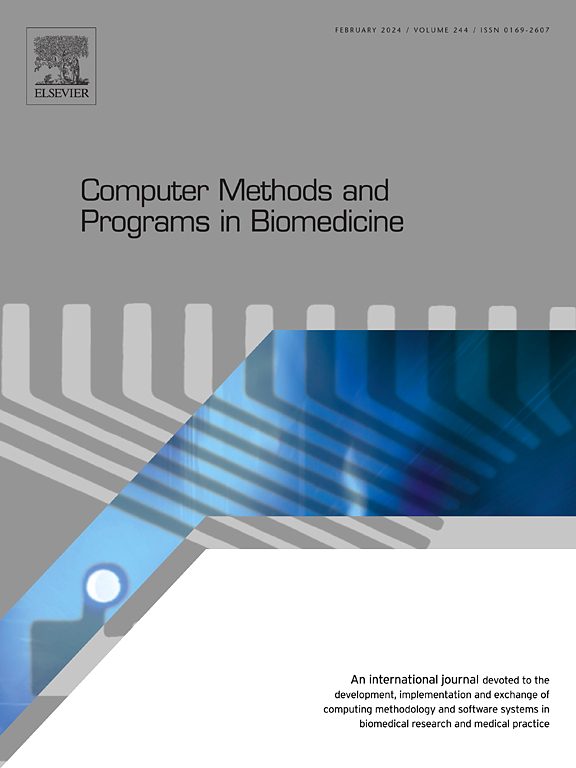Interpretable machine learning models based on body composition and inflammatory nutritional index (BCINI) to predict early postoperative recurrence of colorectal cancer: Multi-center study
IF 4.8
2区 医学
Q1 COMPUTER SCIENCE, INTERDISCIPLINARY APPLICATIONS
引用次数: 0
Abstract
Background and objective
Colorectal cancer (CRC) ranks among the most prevalent cancers worldwide, with early postoperative recurrence remaining a major cause of mortality. Body composition and inflammatory-nutritional indices (BCINI) have demonstrated potential in reflecting patients’ physiological states; however, their association with early recurrence (ER) after CRC resection remains unclear. This study aimed to establish and validate interpretable machine learning (ML) models based on BCINI to predict ER after CRC resection.
Methods
Data from three hospitals were collected, including CT-based body composition metrics and blood test variables. After variable selection, six ML algorithms—XGBoost, Complement Naive Bayes (CNB), support vector machine (SVM), k-nearest neighbors (KNN), random forest (RF), and Gaussian Naive Bayes (GNB)—were used to construct ER prediction models. Optimal model selection was based on receiver operating characteristic (ROC) curve analysis. The selected model was externally validated using independent datasets to assess generalizability, while its accuracy and clinical utility were evaluated via calibration curves and decision curve analysis. Additionally, SHapley Additive exPlanations were employed to visualize prediction processes for clinical interpretability.
Results
The XGBoost algorithm outperformed other methods in model selection, demonstrating superior accuracy and stability with area under the ROC curve (AUC) values of 0.837 and 0.777 in internal training and validation sets, respectively. This model achieved the lowest Brier score of 0.131 on calibration curves, surpassing the five other ML algorithms. External validation further confirmed its generalizability, yielding AUC values of 0.783 and 0.773 in two independent datasets. Consistent predictive performance was observed across age subgroups (<60 years: AUC 0.762–0.834; ≥60 years: AUC 0.777–0.800) and tumor location subgroups (colon: AUC 0.785–0.845; rectum: AUC 0.751–0.799).
Conclusions
The interpretable ML model developed based on BCINI shows promise in predicting ER of CRC. This approach may provide valuable insights for clinical decision-making, enabling early detection and intervention to improve patient outcomes.
基于身体成分和炎症营养指数(BCINI)的可解释机器学习模型预测结直肠癌术后早期复发:多中心研究
背景与目的结直肠癌(CRC)是世界上最常见的癌症之一,术后早期复发仍然是死亡的主要原因。身体成分和炎症营养指数(BCINI)已被证明具有反映患者生理状态的潜力;然而,它们与结直肠癌切除术后早期复发(ER)的关系尚不清楚。本研究旨在建立并验证基于BCINI的可解释机器学习(ML)模型,以预测结直肠癌切除术后的ER。方法收集三家医院的数据,包括基于ct的身体成分指标和血液检测变量。在变量选择后,使用xgboost、补体朴素贝叶斯(CNB)、支持向量机(SVM)、k近邻(KNN)、随机森林(RF)和高斯朴素贝叶斯(GNB) 6种ML算法构建ER预测模型。最优模型选择基于受试者工作特征(ROC)曲线分析。所选模型使用独立数据集进行外部验证,以评估其通用性,同时通过校准曲线和决策曲线分析评估其准确性和临床实用性。此外,SHapley加性解释用于可视化临床可解释性的预测过程。结果XGBoost算法在模型选择上优于其他方法,在内部训练集和验证集的ROC曲线下面积(AUC)分别为0.837和0.777,准确度和稳定性均优于其他方法。该模型在校准曲线上的Brier得分最低,为0.131,超过了其他五种ML算法。外部验证进一步证实了其泛化性,在两个独立的数据集上得到的AUC值分别为0.783和0.773。各年龄亚组观察到一致的预测性能(60岁:AUC 0.762-0.834;≥60岁:AUC 0.777-0.800)和肿瘤位置亚组(结肠:AUC 0.785-0.845;直肠:AUC 0.751-0.799)。结论基于BCINI建立的可解释ML模型在预测结直肠癌ER方面具有良好的应用前景。这种方法可能为临床决策提供有价值的见解,使早期发现和干预能够改善患者的预后。
本文章由计算机程序翻译,如有差异,请以英文原文为准。
求助全文
约1分钟内获得全文
求助全文
来源期刊

Computer methods and programs in biomedicine
工程技术-工程:生物医学
CiteScore
12.30
自引率
6.60%
发文量
601
审稿时长
135 days
期刊介绍:
To encourage the development of formal computing methods, and their application in biomedical research and medical practice, by illustration of fundamental principles in biomedical informatics research; to stimulate basic research into application software design; to report the state of research of biomedical information processing projects; to report new computer methodologies applied in biomedical areas; the eventual distribution of demonstrable software to avoid duplication of effort; to provide a forum for discussion and improvement of existing software; to optimize contact between national organizations and regional user groups by promoting an international exchange of information on formal methods, standards and software in biomedicine.
Computer Methods and Programs in Biomedicine covers computing methodology and software systems derived from computing science for implementation in all aspects of biomedical research and medical practice. It is designed to serve: biochemists; biologists; geneticists; immunologists; neuroscientists; pharmacologists; toxicologists; clinicians; epidemiologists; psychiatrists; psychologists; cardiologists; chemists; (radio)physicists; computer scientists; programmers and systems analysts; biomedical, clinical, electrical and other engineers; teachers of medical informatics and users of educational software.
 求助内容:
求助内容: 应助结果提醒方式:
应助结果提醒方式:


